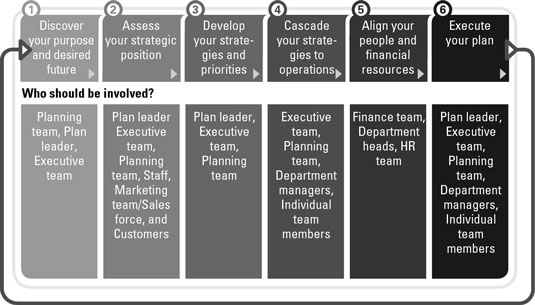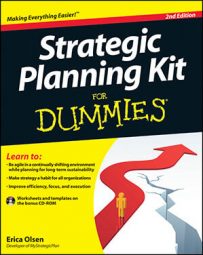The values and vision of your organization are embedded in the strategic framework. As a result, involving the whole organization in at least part of the planning process is vital. Although everyone can’t be involved in every part of the process, each person plays a role. Yes, you want everyone involved (at certain times). Thankfully, you can include everyone in a way that isn’t a recipe for disaster.
As you begin your planning process, you first need to identify who will be on the planning team. From there, you can begin determining who will be department leads (if your organization structure calls for this level), and what team members to include.
The role of the CEO in strategic planning
The CEO naturally assumes a prominent role on the planning team, setting the vision, driving that vision, and enforcing results. If strategic planning isn’t the CEO’s passion, it’ll never happen. Only the CEO has the force to drastically change the company’s alignment. However, during the strategy development part of the planning process, the CEO should remain in the background so other members’ ideas can emerge.
You can’t overemphasize the visibility of the CEO in the strategic management process. The CEO should attend as many planning sessions as possible, including the annual, quarterly, and monthly meetings.
The strategic planning team members
The planning team’s ideal size is 9 to 15 members with an outside facilitator and an internal coordinator. Planning team members should represent different segments of the company — not just the top-level employees, such as the vice presidents, division and department heads, and other executive level managers who report to the CEO. A team consisting of operating, marketing, and sales personnel brings balance when it comes to considering internal and external needs.
Search out key players from your employees, board members, and top management who can help you strategize. Figure out how to get them involved. If some employees can’t take part in person, share early drafts of the plan with them and get their feedback as the process continues. Make sure that you tap your big-picture thinkers as well as get a diverse set of perspectives.
Everyone has a role in strategic planning
Employees who have a chance to contribute feel they’re making a difference. Being part of the strategic management process is exciting, so make sure that everyone has this opportunity. Employees always have different perceptions from top management on how the business is run. You’ll be amazed at the outstanding ideas that come from your employees.
To help ensure planning success, the team must solicit its opinions in a confidential, risk-free atmosphere. Try the following ideas to gather employee information:
Small group meetings: If you have an open and honest company culture, small groups are a good way to get input from your staff. The benefit to bringing groups together is synergy that results from the discussions and brainstorms.
Anonymous surveys: Anonymous online surveys allow every employee to voice his or her own opinion, without being influenced by others.
Assessments: Numerous staff assessments are available that evaluate everything from satisfaction to specific actions and strategies.
Non-employees’ role in strategic planning
Consider the input of people who don’t work for your company. These folks include customers and suppliers who frequently have unique insights into your business. Customers can identify problems the plan should address, and they may have ideas about how to improve overall effectiveness.
Suppliers can offer alternatives to operational problems that hinder delivery of products or services to customers. Although gathering info from these non-employees may not feel comfortable, if you can make it happen, you’ll find it very worthwhile.
The strategic plan manager
The CEO must appoint a respected member of the staff to champion the strategic plan. The strategic plan manager’s responsibility is to keep the process moving forward, monitor progress, and alert decision makers if the company strays off strategy or performance.
Although the strategic plan manager position may add responsibility to a staff member’s current role, managing the strategic plan is critical to the organization’s success, so appoint someone who’s seeking additional responsibility and is looking to move up in the organization. This role is a fabulous leadership development opportunity.
Who’s involved in strategic planning when?
The next question to ask is, “Who should be involved at what stage in the planning process?” Running a strategic planning process democratically isn’t the best way to go. Set expectations before you jump in to the process so no one feels blind-sided or left out.
The figure maps the different stages of the planning process to the different groups of people who should be involved. As you can see in the figure, the CEO and strategic plan manager are involved in just about every step of the process. Other groups take part where needed. Use this chart as a guide to develop your own planning team.


